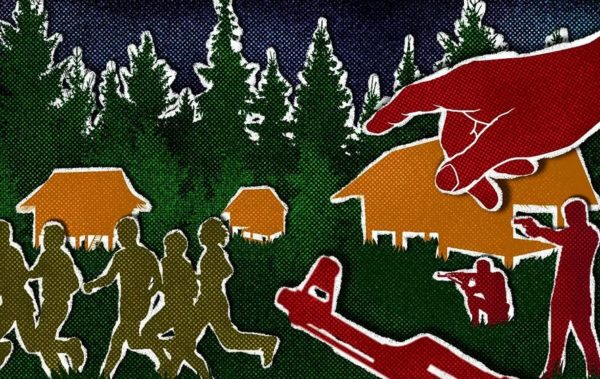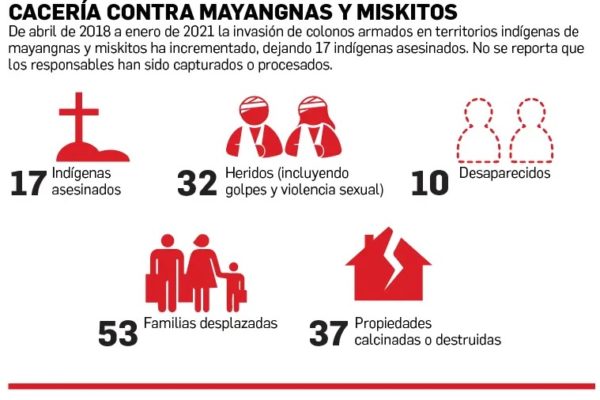Deadly Invasions Persist in Nicaraguan Indigenous Lands
“I Can’t Go Back Home, they are still killing people there.”

The bloody toll of the invasion of squatters, from April 2018 to date: 17 Mayangna and Miskito indigenous have been killed. No one has been arrested and sentenced.
By Ana Lucía Cruz (Confidencial)
HAVANA TIMES – The image of the murders remain intact in her memory. On that December 15, 2015, “Juana” was standing in the hallway of her wooden home. She heard shouts and shots. Despite the “uproar”, the woman, who is a member of the Misquito community, decided to go to the door. There, she could discern a group of armed men who were invading “Esperanza of the Wawa River”, her North Caribbean community.
“Juana” manage to flee with eight of her thirteen children. She’d witnessed the “fury” of the colonists and seen a neighbor and her brother-in-law killed.
That event reached the ears of the Inter-American Commission for Human Rights. The Commission asked the Inter-American Court to implement provisional protective measures. Their denunciation described how some 200 land invaders entered that Miskito community, then attacked and killed two of the indigenous residents. Like “Juana” and her children, another twenty families were forced to leave their homes and go elsewhere, to safeguard their lives. Today, the invasions haven’t ended, and the fear continues.
Five years after the attack, “Juana” is still afraid. For that reason, she asked to be identified only with an alias. She’s only returned twice to the community where she lived for 47 of her 52 years. She went back on those occasions to see her other children. They “didn’t want to leave there”, she stated, but added that she herself “only lasted one night.”
In the community that had been her home, she couldn’t sleep, because of her fear. Noises from the animals around made her nervous, reviving images of the “colonists coming in” to sweep her community away.

“I don’t feel safe to return to my community. I can’t go back, because I know they’re still killing us. I keep thinking the land invaders could arrive at any minute. They could go back to doing the same thing they did to my neighbor and my brother-in-law,” she shared.
Land colonizers on “a hunt”
Attacks of armed colonists against the Mayangna and Miskito indigenous peoples are on the rise.
Confidencial analyzed the data from attacks reported over the last few years. Their examination confirmed that from April 2018 to 2021, there’s been an increase in colonist invasions. Their bloody advance into the indigenous lands has left 17 indigenous people murdered. Up to the present, there’s been no word of any detentions or trials of those responsible.
The year 2020 was an especially disastrous. A total of thirteen indigenous people were murdered. This information came from a report released this week by the Nicaraguan Center for Human Rights, (Cenidh). They worked in collaboration with the Center for Legal Services to Indigenous Peoples (Calpi), the Center for Justice and Human Rights for the Nicaraguan Atlantic Coast (Cejudhcan), and the Observatory for the Protection of Human Rights Advocates (OMCT).
The document details the assassination of 49 indigenous people between 2011 and 2020. In addition, 49 others were wounded and 50 kidnapped or missing.
The attacks have one thing in common. They were carried out by non-indigenous persons. The majority were armed with shotguns, AKA or 22-caliber rifles, and machetes. The original denunciations were made by the indigenous territorial and communal governments, and organizations of civil society in the zone.
As the squatter armies pass through, the indigenous communities are destroyed. From April 2018 to February 2021, vast destruction has been documented in this zone. Dozens of houses, centers of worship, health centers, schools and grain and harvest storage centers have been destroyed and burned. The objective? To force community members to abandon their fields. In the last 38 months, more than fifty families have been displaced from their territory.
According to Cejudhcan, up through 2019, more than a thousand people have been displaced from twelve communities. They have all received provisional protective measures. Their protection was ordered by the Inter-American Commission for Human Rights and the Inter-American Human Rights Court respectively.
Communities benefitted by these measures include Esperanza of the Wawa River, where “Juana” lived. Others are Santa Clara, Wisconsin, Francia Sirpi, San Jeronimo, Santa Fe, Esperanza of the Coco River, Klisnak, Cocal, Naranjal and Wiwinak. All of these communities form part of the Waspam municipality in the North Caribbean. Unfortunately, the Nicaraguan government hasn’t complied with the protective measures decreed.
The Nicaraguan government “promotes” impunity
Organizations involved with these communities affirm that the attacks on them and their indigenous inhabitants are “systematic and violent”. Among the victims are advocates of the Mayangna and Miskito ethnic groups. These tribes are native to the Coco and Wangki Rivers and the Bosawas Biological Reserve.
The increase in the attacks goes hand in hand with impunity. According to the organizations, “the perpetrators of illegal land trafficking, who usurp the land and natural resources,” see themselves as favored by “the state authorities. There seems to be a policy of internal colonization that the State is covering up.”
At the same time, all these menaces, aggressions, murders and forced displacements “aren’t investigated by the Nicaraguan authorities. As a result, the material and intellectual authors are never brought to justice.”
Lottie Cunningham, human rights lawyer and founder of Cejudhcan, affirms that the indigenous territories have been “gravely impacted”. She warns that they’re moving towards “an imminent ethnocide.”
The advocate recalls that ethnocide occurs with the “continuous loss of their territories” for the indigenous groups. That, in turn, can lead to the “loss of their cultural identity,” with the “pressure of the forced displacement. They also face institutionalized racial discrimination, social exclusion and a lack of concrete state action to protect the community’s territory.”
Representatives of the Mayangna Territorial and Communal Government spoke with Confidencial on condition of anonymity. They, too, criticize the authorities. “They haven’t detained anyone; at least, they haven’t informed us of any.”
There’ve been no detentions, for either the oldest attacks or the most recent. The latter was registered on January 22, 2021, in Wilus, of the Sauni As territory. In that territory, in the heart of the Bosawas Biological Reserve, three members of the Mayangna indigenous group received bullet wounds. Another fairly recent attack took place in the Alal community, also within the Sauni As territory. That attack in January 2020 left four people killed, two wounded and fifteen homes burnt to the ground.
The Mayangna leaders recognized that between November 2019 and January 2020, they had “support from the police and the army.” These, they affirm, “managed to dislodge several squatters from the Suniwas and Bethlehem sectors with their presence. They “detained three of the heads of the invading colonists”.
Nonetheless, they complained, on at least two occasions the Nicaraguan authorities have let the arrested colonists go free. The communal leaders added that the detention of the three leaders in November 2019 “was useless. The same officials who detained them, later freed them without filing charges.” In November 2017, in the community of Wilus, they also arrested eight squatters. But after two months of detention, they were released by order of a judge in the city of Bonanza.
“I know the risks we’re running here”
The demand for justice is ever stronger among the Mayangna and Miskito indigenous peoples. Despite their difficulties communicating in Spanish, they want to be heard.
“Jose” is a member of the Alal community who fled after the attack on January 29, 2020. He tells his story in broken Spanish. He continues hoping that “someone will do something, to liberate” his community, now besieged by colonists. Not only his community, but all the Mayangna territory in Bosawas.
“Jose” uses an assumed name to protect his identity. He describes himself as “one of the heads of the community”. He affirms that after finding out about “the first deaths”, they decided to evacuate most of the community members. They needed to “preserve life”.
“The same day that they warned they were attacking us, that they killed our people, we decided to save life. Some 300 people left. We couldn’t be there when the enemy came. Everything was abandoned. Some ran further into the mountains, and others went to other communities,” he detailed.
The community leader asserted that he was only away from the community a couple months. However, he assures that the fear of a new attack is always there, latent.
“I returned to the community after fleeing from the colonists. But we know that they continue making trails. They harass us. The threat is always there, and you don’t know when you might have to leave again,” “Jose” stated with regret.
Cenidh, Cejudhcan, Calpi and OMCT are all demanding that the government take action. They must “immediately adopt measures to guarantee the security and the physical and psychological integrity of the peoples and communities”.
The January 22nd attack on the Wilus community has motivated the Mayangna community to launch a campaign. They’re demanding that their territories be free of invaders. Organizations such as Cenidh have added their voices. They denounce the attacks documented in the last years and demand “urgent” actions from the Nicaraguan government.
The objective of the colonists, “Jose” affirms, is “to take our home, our community, away from us”. His demand, he repeats, is the same as that of hundreds of indigenous people. “That they help us to free our territory of land invaders. So we can live in peace on our lands. We don’t have weapons. We don’t have anything, and no one does anything to help us.”





